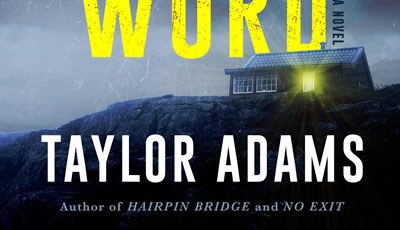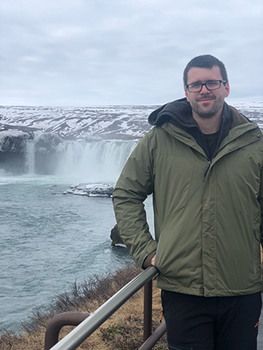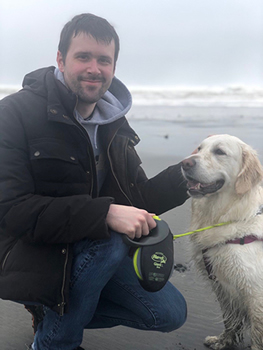

Latest Books Up Close: Taylor Adams
A One-Star Review Can be Deadly
In one of the creepiest thrillers you’ll read this year, schoolteacher Emily Carpenter has no idea what she’s getting into when she gives author H. G. Kane a one-star review for his poorly written novel. Alone in a remote beach house on the rain-swept Washington coast, she walks her dog Laika along the beach and reads cheap novels to escape the pain of a personal loss. Emily’s only neighbor, a quarter mile away, is Deek Cowl a man with whom she communicates via messages written on a whiteboard and viewed through a telescope.
Kane, whose real name is Howard Grosvenor Kline, demands she retract her review, but she refuses. When strange occurrences happen—a ghostly figure in her bedroom late at night and other disturbances—Emily wonders if the author might be stalking her. As she probes Kline’s background, she discovers his sixteen novels are all sadistic tales of stalking and murder. Could Kline have her in his crosshairs as the plot for his next book?
Award-winning author Taylor Adams, whose four other acclaimed novels include No Exit and Hairpin Bridge, piles on terror laced with heart-stopping twists, until you can’t imagine what will happen next.
The Big Thrill sat down with Adams to ask about his roller-coaster storylines, how he maximizes the pressure on characters, and striking the right tone.
A reader who gives an author a one-star review, but then has to face his revenge—a deceptively simple, but not very common premise. What inspired it?
I’ve always found the Internet scary—it’s like staring into an unknown void, and as we know, sometimes the void stares back. As an author, I know how hurtful one-star reviews can be. The idea of provoking a serial killer with something as innocent as an online book review was both darkly comic and terrifyingly plausible, so I knew I had to write it!
You are known for placing a small cast of characters in a confined space for a short time frame. Why does that focus work for you, as opposed to more epic stories?
I like to keep my thrillers simple and contained to maximize the pressure on the characters. It’s certainly possible to build tension in a much broader story structure, but isolation and urgency are two of my favorite suspense-writing tools, and I love to use them. (I also admittedly have a fairly short attention span, so the punchier the story is, the easier it is for me to stay interested in writing it!)
Have you always been a writer, and what led you to choose writing as a career?
I’ve always been fascinated with storytelling in various forms—as a child I loved to draw cartoons before turning my attention to screenwriting and eventually novel writing. Growing up in Washington, my first attempt at a novel in middle school was a disaster thriller about Mount Rainier erupting (the less said about that, the better). Luckily, I think my work has improved since then.
You began your career in film and have won awards in that world. Which appeals to you more, moviemaking or novel-writing, and why? Which will be your main focus going forward?
I really enjoy the creative freedom that comes with novel-writing. Seeing No Exit adapted for the screen was thrilling (and I really enjoyed the movie), but a lot of different artistic voices go into making a film, while a novel is a more personal and individual expression. Although I’d like to do more screenwriting as my career develops, novel writing is what pays the bills right now, so I’ll keep at it.
Which comes first for you, plot or character, or some combination of the two?
It’s tough to pick a side in the battle of Plot vs. Character. They’re so inextricably linked. I heard someone say that “a plot is characters under pressure” and I think that’s very accurate. The protagonist and antagonist’s goals are often what put them on their collision course and drive the story forward. That said, when developing a story I tend to start with a situation with dramatic stakes that interest me, which means I’m probably on Team Plot.
You have incredible plot twists, especially toward the end of THE LAST WORD. How in the world do you come up with them, and what makes them successful?
By working backwards, actually. I started with the story’s core climactic conflict—Emma’s personal battle with her grief—and then layered it so the stalker-on-the-loose story gradually peels away to reveal Emma’s true stakes (and a villain who is perfectly positioned to take advantage). When you get down to it, plot twists are often really “reveals,” and I think the key to an effective one is that it deepens the characters or stakes by showing you something new, like uncovering more of an iceberg under the surface.
Flawed, but resourceful female protagonists against brilliant, but creepy male antagonists seem to be a recurring theme in your work. What is it about this that captures your imagination? What inspired Emily, as well as Howard and Deek?
I love cat and mouse thrillers, so that sort of plucky heroine vs. sick villain dynamic always seems to be present in my work. With these three central characters, I also wanted to explore the reader vs. author relationship. Some of the story is presented as a “book within a book,” which allowed me to explore the villain’s perspective in some very amusing ways. And because Emma herself is a voracious (and jaded) reader, it’s only appropriate that she be a step or two ahead of the crappy horror novel she’s found herself trapped inside.
Antagonists with “mother issues” also seem to be a theme. What appeals to you about this?
I designed the antagonist of THE LAST WORD to be sort of a subversion of the masked killer archetype; something that’s terrifying in the dark, but sad and even laughable when the lights are on. This guy came to Emma through the Internet, after all. I had a lot of fun building up this character in the first half like a nigh-immortal 80’s slasher villain—right down to a distinctive bladed weapon—before revealing the true evil to be more mundane, albeit no less dangerous. I suppose “mother issues” might be putting it lightly!
Of all the unnerving developments in this story, the ones that terrified us the most were around Laika, Emily’s dog. How did you decide your approach?
Laika’s actually a real dog: my English cream golden retriever. I’d written Laika into the story’s first draft as a placeholder, intending to write a fictional dog in later drafts, but ultimately I just liked her too much to change her. Of course, this meant there was zero chance that fictional Laika would come to any harm. And Laika gets to bite the bad guy at the end, which is only fair.
What research did you have to do for this story?
I learned quite a bit about swords, of all things! A samurai sword may be an outlandish choice for a murder weapon, but the danger Emma faces is also 100% true to real-life. One swing from one of those things can amputate a limb. Yikes. This mixture of the absurd and the authentically terrifying was exactly the tone I tried to strike for this story.
What’s next?
Another thriller novel! No surprise there. But I’m having a lot of fun and look forward to sharing some details soon…
- Bruce Borgos - August 8, 2024
- The Big Thrill Recommends: SERVED COLD by James L’Etoile - July 26, 2024
- The Big Thrill Recommends: THE PARIS VENDETTA by Shan Serafin - June 27, 2024





